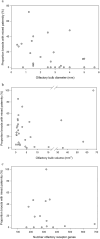The Importance of Olfaction for Mixed Paternity in Birds
- PMID: 39823114
- PMCID: PMC11737898
- DOI: 10.1002/ece3.70863
The Importance of Olfaction for Mixed Paternity in Birds
Abstract
Olfaction can aid individuals in finding genetically compatible mates in many animals, while high levels of mixed paternity may result from a limited ability to evaluate their mate's genetic profile against their own before mating. To test this suggestion and explore if olfaction may indeed influence mating patterns in birds, we combined published measures of olfactory ability with data on genetic mating pattern in the same species, across a phylogenetically broad range of species. We used three measures of olfaction: (1) olfactory bulb diameter, (2) olfactory bulb volume and (3) number of olfactory receptor genes (148, 134 and 48 species, respectively). These measures were then matched to species-specific estimates of mating pattern, measured as percentage of broods with mixed paternity (> 1 male siring offspring in the same brood). Limited overlaps between the datasets resulted in 30 matched species for olfactory bulb diameter, 31 for olfactory bulb volume and 15 for olfactory receptor genes. Controlling for brain size (telencephalon), we then correlated olfaction to mating pattern, and found that the bigger the relative olfactory bulb diameter, the lower the proportion of mixed paternity. In contrast, there was no significant correlation between olfactory bulb volume or number of receptor genes and paternity. This study thus indicates that mating patterns in birds may be influenced by olfactory ability, measured as olfactory bulb diameter. Next, we suggest expanding the datasets by collecting olfactory-focused measures, targeting species for which paternity measures already exist, to allow a full phylogenetic analysis.
Keywords: extra‐pair paternity; genetic compatibility; mate choice; monogamy; odour; promiscuity.
© 2025 The Author(s). Ecology and Evolution published by John Wiley & Sons Ltd.
Conflict of interest statement
The authors declare no conflicts of interest.
Figures

Similar articles
-
Mating system and extra-pair paternity in the Fan-tailed Gerygone Gerygone flavolateralis in relation to parasitism by the Shining Bronze-cuckoo Chalcites lucidus.PLoS One. 2018 Mar 8;13(3):e0194059. doi: 10.1371/journal.pone.0194059. eCollection 2018. PLoS One. 2018. PMID: 29518150 Free PMC article.
-
Experimental Manipulation of Polyandry in a Marine Gastropod Reveals How the Number of Mates Affects Reproductive Output, Offspring Size, and the Distribution of Paternity Within Broods.Ecol Evol. 2025 Jun 1;15(6):e71505. doi: 10.1002/ece3.71505. eCollection 2025 Jun. Ecol Evol. 2025. PMID: 40458814 Free PMC article.
-
Measuring Pre- and Post-Copulatory Sexual Selection and Their Interaction in Socially Monogamous Species with Extra-Pair Paternity.Cells. 2021 Mar 11;10(3):620. doi: 10.3390/cells10030620. Cells. 2021. PMID: 33799610 Free PMC article.
-
Why do females mate multiply? A review of the genetic benefits.Biol Rev Camb Philos Soc. 2000 Feb;75(1):21-64. doi: 10.1017/s0006323199005423. Biol Rev Camb Philos Soc. 2000. PMID: 10740892 Review.
-
Age trajectories in extra-pair siring success suggest an effect of maturation or early-life experience.J Evol Biol. 2023 Sep;36(9):1213-1225. doi: 10.1111/jeb.14201. Epub 2023 Jul 12. J Evol Biol. 2023. PMID: 37438929 Review.
References
-
- Arct, A. , Drobniak S., and Cichoń M.. 2015. “Genetic Similarity Between Mates Predicts Extrapair Paternity—a Meta Analysis of Bird Studies.” Behavioral Ecology 26, no. 4: 959–968. 10.1093/beheco/arv004. - DOI
-
- Bang, B. G. 1971. “Functional Anatomy of the Olfactory System in 23 Orders of Birds.” Acta Anatomica 58: 1–76. - PubMed
-
- Bang, B. G. , and Cobb S.. 1968. “The Size of the Olfactory Bulb in 108 Species of Birds.” Auk 85, no. 1: 55–61.
LinkOut - more resources
Full Text Sources

